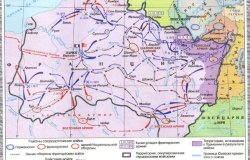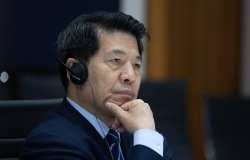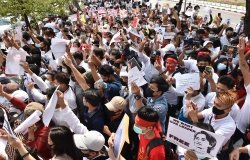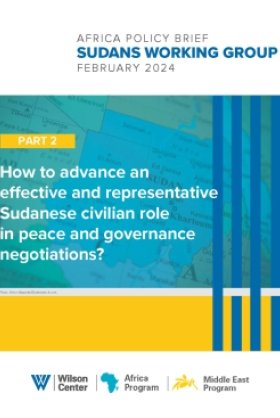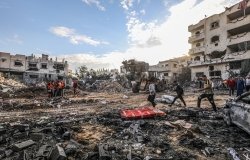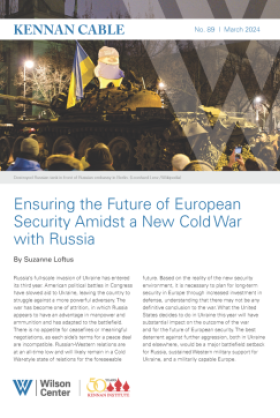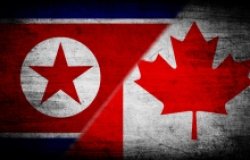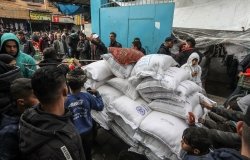The Responsibility to Protect: Ending Mass Atrocity Crimes Once and for All
The international community's has habitually failed to react quickly, appropriately, or at all to mass atrocity crimes and humanitarian crises practically since the concept of state sovereignty was formed, and that indifference to the plight of far-off countries is now institutionalized.
Overview
On Tuesday, September 28, 2008, the Project on Leadership and Building State Capacity, in partnership with the United Nations Association of the National Capitol Area, hosted Gareth Evans, president of International Crisis Group (ICG) and author of the new book, The Responsibility to Protect: Ending Mass Atrocity Crimes Once and for All (Brookings 2008). Mr. Evans has served as President and CEO of ICG since 2000. He was a member of the Australian Congress for 21 years, and one of Australia's longest-serving Foreign Ministers. Evans was co-chair of the International Commission on Intervention and State Sovereignty, appointed by the Government of Canada, which published its report, The Responsibility to Protect, in December 2001.
Part of United Nations Week 2008, this event was opened by Howard Wolpe, Director, Project on Leadership and Building State Capacity, and A. Ed Elmendorf, President, United Nations Association of the National Capitol Area.
Evans began by outlining the conceptual foundations of Responsibility to Protect, or R2P. The international community's has habitually failed to react quickly, appropriately, or at all to mass atrocity crimes and humanitarian crises practically since the concept of state sovereignty was formed, and that indifference to the plight of far-off countries is now institutionalized. Accordingly, many leaders have cited the United Nations charter in reference to preservation of state sovereignty to avoid entanglement in interventions elsewhere. This trend has continued, if not intensified, in the post-Cold War era. Evans' goal is the formation a global consensus to ensure that the world does not once again fail to act to avert genocide and crimes against humanity—a call to action with both logical and emotional appeal called the Responsibility to Protect.
Working with Mohamed Sahnoun, Evans co-chaired the International Commission on Intervention and State Sovereignty (ICISS), appointed by the Government of Canada, which produced the report The Responsibility to Protect in 2001. In the report, as in Evans' book, R2P is framed not as intervention, but as an international responsibility to the victims and potential victims of mass atrocity crime. R2P includes conflict prevention and post-conflict reconstruction, as well as immediate, measured response when conflict does break out, applying appropriate pressure to governments and leaders to reach peaceful, political settlements.
One of the challenges that Evans identified in convincing UN member states to adopt R2P was the perception that it necessarily obligates a wealthy nation to take action, or overrides the sovereignty of a poorer, weaker nation. At the moment, consensus on R2P is evasive, but Evans believes that the international community is coming ever closer to accepting a legal standard for preventing and reacting to such catastrophes. Still, he cautioned that the nuance and practical elements of taking military, economic, and diplomatic action appropriate to each situation remain to be settled, and political will must be present.
Evans suggested that R2P suffers from two main misconceptions: first, that R2P is simply coercive military response; and second, that the scope of permissible action justified under R2P is excessively broad, encompassing all human rights violations and injustices in the world. R2P represents much more than military intervention. It includes prevention and legal, constitutional, economic, and diplomatic responses to conflict, avoiding military means if possible. The criteria to be satisfied for military action are extensive, and such a decision would be taken only in full consideration of possible consequences. Even in cases where military action is used, it must be proportional. Evans reiterated that R2P is specifically intended to defend against mass atrocity crimes, which occur much more rarely than do general human rights infractions. He cited Cyclone Nargis, which decimated southern areas of Burma/Myanmar in May 2008, as a case in which R2P did not apply. Despite the Burmese government's reluctance to admit aid workers, worsening the humanitarian situation, the military junta did not commit mass atrocity crimes.
Evans cited three other recent cases to illustrate the application of R2P: Kenya's post-election violence in late 2007 into 2008; Russia's incursion into Georgia in 2008; and the ongoing crisis in Darfur. Kenya's situation was perfectly compatible with the intentions and requirements of R2P. Violence broke out quickly after the highly disputed election, and soon mass atrocity crimes were occurring. Evans cited the international community's timely political and diplomatic pressure to stop violence and encourage a political solution as a successful incidence of R2P. The situation in Darfur is unequivocally an R2P case, with the Sudanese government directly responsible for mass atrocity crimes. Many people are calling Darfur a failure of R2P due to weak and ineffectual international response which has yet to produce a long-term political solution. However, it is widely thought that military intervention would exacerbate the situation. Evans advocates continuing to pursue criminal charges against President Omar al-Bashir. Evans called Moscow's framing of its recent incursion into Georgia as R2P cynical and incorrect. Russia claimed to be taking action under R2P to protect its own citizens, a right of the state in any case. However, the Russian Federation's military response was neither proportional nor a last resort, both requirements for military action under R2P. Evans emphasized that misuse of R2P rhetoric would destabilize this worthy effort, and potentially reinforce the misconceptions that it is too broad in scope or disproportionately serves the interest of the powerful.
The institutional capacity for R2P is growing, but must operate solely under the authority of the Security Council, so as not to delegitimize the legal and institutional foundation upon which R2P stands and seeks to promote. The moral authority of the General Assembly is also a critical component of Responsibility to Protect. Currently, China and Russia have both endorsed the idea. However, Beijing recently vetoed action in Zimbabwe, and as discussed, Moscow has now wrongly applied the concept to intervention in Georgia. Evans called for the international community to prevent R2P from becoming an excuse for regime change or inappropriate intervention. As a future resource, he pointed the audience to the Responsibility to Protect Center, recently opened in New York, which will help governments to participate in R2P missions and respond appropriately.
Evans closed by sharing his hope that when the next mass atrocity crime happens, the international community will respond definitively, and that we will not be left to repeat "never again."
Drafted by Gregor Young
Hosted By

Africa Program
The Africa Program works to address the most critical issues facing Africa and US-Africa relations, build mutually beneficial US-Africa relations, and enhance knowledge and understanding about Africa in the United States. The Program achieves its mission through in-depth research and analyses, public discussion, working groups, and briefings that bring together policymakers, practitioners, and subject matter experts to analyze and offer practical options for tackling key challenges in Africa and in US-Africa relations. Read more
Thank you for your interest in this event. Please send any feedback or questions to our Events staff.
